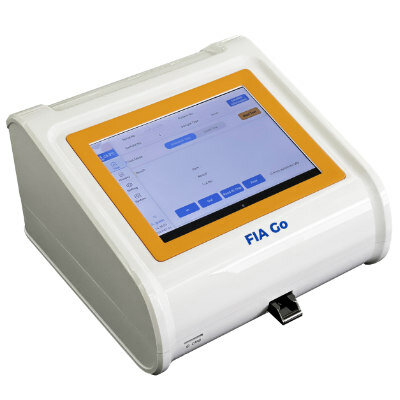FABP4 Concentrations Quantified in Proliferative Diabetic Retinopathy
|
By LabMedica International staff writers Posted on 07 Jul 2021 |

Image: Enzyme-linked immunosorbent assay (ELISA) kit for Fatty acid-binding proteins 4 (FABP4) (Photo courtesy of Biovendor R&D)
Proliferative diabetic retinopathy (PDR), a progressive and serious stage of diabetic retinopathy (DR) due to retinal ischemia, is characterized by neovascularization (NV), vitreous hemorrhaging (VH) and tractional retinal detachment (TRD), all of which are major causes of blindness in patients with diabetes mellitus (DM).
Fatty acid-binding proteins (FABPs) that act as intracellular lipid chaperones are a group of molecules that coordinate lipid responses in cells. Among the currently known FABPs, the FABP4, known as adipocyte FABP (A-FABP) or aP2, is expressed in both adipocytes and macrophages, and can be detected in most bodily fluids.
Scientists specializing in Ophthalmology at the Sapporo Medical University School of Medicine (Sapporo, Japan) and their colleagues recruited 20 PDR patients (mean age 63.27 ± 11.9 years; 10 males and 10 females), and 20 non-DR patients (mean age 69.2 ± 9.1 years; eight males and 12 females). Body height and weight measurements, blood pressure measurements and the collection of peripheral blood specimens for a complete blood count and biochemical analyses were performed.
The team performed biochemistry measurements of the vitreous concentrations of FABP4 (V-FABP4) or vascular endothelial growth factor A (V-VEGFA) and several blood chemistry analyses including plasma glucose levels, hemoglobin A1c (HbA1c), creatinine (Cr), blood urea nitrogen (BUN), uric acid, aspartate transaminase (AST), alanine aminotransferase (ALT), γ-glutamyl transpeptidase (γ-GTP), lipid profiles, including total cholesterol and triglycerides, high-sensitivity C-reactive protein (hsCRP) and estimated glomerular filtration rate (eGFR). The concentrations of V-FABP4 (ng/mg protein) or V-VEGFA (pg/mg protein) were determined by enzyme-linked immunosorbent assay for FABP4 (Biovendor R&D, Modrice, Czech Republic) or human VEGFA (Fuji film Wako. Co., Osaka, Japan), respectively.
The investigators reported that the levels of V-FABP4 and V-VEGFA were significantly higher in PDR patients than in non-PDR patients with a high positive correlation between them. The findings were not affected by body mass index values and the presence of vitreous hemorrhaging. Among the clinical parameters, V-FABP4 correlated positively with creatinine and negatively with age and aspartate transaminase (AST) levels, while V-VEGFA correlated positively with fasting plasma glucose and hemoglobin A1c (HbA1c) levels, but negatively with AST. Multiple regression analyses indicated that V-VEGFA, or V-FABP4, AST and HbA1c were independent predictors of V-FABP4 or V-VEGFA, respectively. Both were negatively correlated, but more evident in V-FABP4, with the optic nerve head (ONH) ocular blood flow.
The authors concluded that the concentrations of both V-FABP4 and V-VEGFA were substantially elevated in eyes with PDR, and a significantly higher positive correlation was observed between them. However, correlation analyses and stepwise multiple regression analyses for V-FABP and V-VEGFA strongly suggested that both factors were independently regulated, suggesting that V-FABP4 might also be involved in the pathogenesis of PDR. The study was published on June 11, 2021 in the journal Scientific Reports.
Related Links:
Sapporo Medical University School of Medicine
Biovendor R&D
Fuji film Wako. Co
Fatty acid-binding proteins (FABPs) that act as intracellular lipid chaperones are a group of molecules that coordinate lipid responses in cells. Among the currently known FABPs, the FABP4, known as adipocyte FABP (A-FABP) or aP2, is expressed in both adipocytes and macrophages, and can be detected in most bodily fluids.
Scientists specializing in Ophthalmology at the Sapporo Medical University School of Medicine (Sapporo, Japan) and their colleagues recruited 20 PDR patients (mean age 63.27 ± 11.9 years; 10 males and 10 females), and 20 non-DR patients (mean age 69.2 ± 9.1 years; eight males and 12 females). Body height and weight measurements, blood pressure measurements and the collection of peripheral blood specimens for a complete blood count and biochemical analyses were performed.
The team performed biochemistry measurements of the vitreous concentrations of FABP4 (V-FABP4) or vascular endothelial growth factor A (V-VEGFA) and several blood chemistry analyses including plasma glucose levels, hemoglobin A1c (HbA1c), creatinine (Cr), blood urea nitrogen (BUN), uric acid, aspartate transaminase (AST), alanine aminotransferase (ALT), γ-glutamyl transpeptidase (γ-GTP), lipid profiles, including total cholesterol and triglycerides, high-sensitivity C-reactive protein (hsCRP) and estimated glomerular filtration rate (eGFR). The concentrations of V-FABP4 (ng/mg protein) or V-VEGFA (pg/mg protein) were determined by enzyme-linked immunosorbent assay for FABP4 (Biovendor R&D, Modrice, Czech Republic) or human VEGFA (Fuji film Wako. Co., Osaka, Japan), respectively.
The investigators reported that the levels of V-FABP4 and V-VEGFA were significantly higher in PDR patients than in non-PDR patients with a high positive correlation between them. The findings were not affected by body mass index values and the presence of vitreous hemorrhaging. Among the clinical parameters, V-FABP4 correlated positively with creatinine and negatively with age and aspartate transaminase (AST) levels, while V-VEGFA correlated positively with fasting plasma glucose and hemoglobin A1c (HbA1c) levels, but negatively with AST. Multiple regression analyses indicated that V-VEGFA, or V-FABP4, AST and HbA1c were independent predictors of V-FABP4 or V-VEGFA, respectively. Both were negatively correlated, but more evident in V-FABP4, with the optic nerve head (ONH) ocular blood flow.
The authors concluded that the concentrations of both V-FABP4 and V-VEGFA were substantially elevated in eyes with PDR, and a significantly higher positive correlation was observed between them. However, correlation analyses and stepwise multiple regression analyses for V-FABP and V-VEGFA strongly suggested that both factors were independently regulated, suggesting that V-FABP4 might also be involved in the pathogenesis of PDR. The study was published on June 11, 2021 in the journal Scientific Reports.
Related Links:
Sapporo Medical University School of Medicine
Biovendor R&D
Fuji film Wako. Co
Latest Immunology News
- Diagnostic Blood Test for Cellular Rejection after Organ Transplant Could Replace Surgical Biopsies
- AI Tool Precisely Matches Cancer Drugs to Patients Using Information from Each Tumor Cell
- Genetic Testing Combined With Personalized Drug Screening On Tumor Samples to Revolutionize Cancer Treatment
- Testing Method Could Help More Patients Receive Right Cancer Treatment
- Groundbreaking Test Monitors Radiation Therapy Toxicity in Cancer Patients
- State-Of-The Art Techniques to Investigate Immune Response in Deadly Strep A Infections
- Novel Immunoassays Enable Early Diagnosis of Antiphospholipid Syndrome
- New Test Could Predict Immunotherapy Success for Broader Range Of Cancers
- Simple Blood Protein Tests Predict CAR T Outcomes for Lymphoma Patients
- Cell Sorter Chip Technology to Pave Way for Immune Profiling at POC
- Chip Monitors Cancer Cells in Blood Samples to Assess Treatment Effectiveness
- Automated Immunohematology Approaches Can Resolve Transplant Incompatibility
- AI Leverages Tumor Genetics to Predict Patient Response to Chemotherapy
- World’s First Portable, Non-Invasive WBC Monitoring Device to Eliminate Need for Blood Draw
- Predictive T-Cell Test Detects Immune Response to Viruses Even Before Antibodies Form
- Single Blood Draw to Detect Immune Cells Present Months before Flu Infection Can Predict Symptoms
Channels
Molecular Diagnostics
view channel
Unique Autoantibody Signature to Help Diagnose Multiple Sclerosis Years before Symptom Onset
Autoimmune diseases such as multiple sclerosis (MS) are thought to occur partly due to unusual immune responses to common infections. Early MS symptoms, including dizziness, spasms, and fatigue, often... Read more
Blood Test Could Detect HPV-Associated Cancers 10 Years before Clinical Diagnosis
Human papilloma virus (HPV) is known to cause various cancers, including those of the genitals, anus, mouth, throat, and cervix. HPV-associated oropharyngeal cancer (HPV+OPSCC) is the most common HPV-associated... Read moreHematology
view channel
Next Generation Instrument Screens for Hemoglobin Disorders in Newborns
Hemoglobinopathies, the most widespread inherited conditions globally, affect about 7% of the population as carriers, with 2.7% of newborns being born with these conditions. The spectrum of clinical manifestations... Read more
First 4-in-1 Nucleic Acid Test for Arbovirus Screening to Reduce Risk of Transfusion-Transmitted Infections
Arboviruses represent an emerging global health threat, exacerbated by climate change and increased international travel that is facilitating their spread across new regions. Chikungunya, dengue, West... Read more
POC Finger-Prick Blood Test Determines Risk of Neutropenic Sepsis in Patients Undergoing Chemotherapy
Neutropenia, a decrease in neutrophils (a type of white blood cell crucial for fighting infections), is a frequent side effect of certain cancer treatments. This condition elevates the risk of infections,... Read more
First Affordable and Rapid Test for Beta Thalassemia Demonstrates 99% Diagnostic Accuracy
Hemoglobin disorders rank as some of the most prevalent monogenic diseases globally. Among various hemoglobin disorders, beta thalassemia, a hereditary blood disorder, affects about 1.5% of the world's... Read moreImmunology
view channel
Diagnostic Blood Test for Cellular Rejection after Organ Transplant Could Replace Surgical Biopsies
Transplanted organs constantly face the risk of being rejected by the recipient's immune system which differentiates self from non-self using T cells and B cells. T cells are commonly associated with acute... Read more
AI Tool Precisely Matches Cancer Drugs to Patients Using Information from Each Tumor Cell
Current strategies for matching cancer patients with specific treatments often depend on bulk sequencing of tumor DNA and RNA, which provides an average profile from all cells within a tumor sample.... Read more
Genetic Testing Combined With Personalized Drug Screening On Tumor Samples to Revolutionize Cancer Treatment
Cancer treatment typically adheres to a standard of care—established, statistically validated regimens that are effective for the majority of patients. However, the disease’s inherent variability means... Read moreMicrobiology
view channel
Mouth Bacteria Test Could Predict Colon Cancer Progression
Colon cancer, a relatively common but challenging disease to diagnose, requires confirmation through a colonoscopy or surgery. Recently, there has been a worrying increase in colon cancer rates among younger... Read more.jpg)
Unique Metabolic Signature Could Enable Sepsis Diagnosis within One Hour of Blood Collection
Sepsis is a life-threatening condition triggered by an extreme response of the body to an infection. It requires immediate medical intervention to prevent potential death or lasting damage.... Read morePathology
view channel
Spatial Tissue Analysis Identifies Patterns Associated With Ovarian Cancer Relapse
High-grade serous ovarian carcinoma is the most lethal type of ovarian cancer, and it poses significant detection challenges. Typically, patients initially respond to surgery and chemotherapy, but the... Read more.jpg)
Unique Hand-Warming Technology Supports High-Quality Fingertip Blood Sample Collection
Warming the hand is an effective way to facilitate blood collection from a fingertip, yet off-the-shelf solutions often do not fulfill laboratory requirements. Now, a unique hand-warming technology has... Read moreTechnology
view channel
New Diagnostic System Achieves PCR Testing Accuracy
While PCR tests are the gold standard of accuracy for virology testing, they come with limitations such as complexity, the need for skilled lab operators, and longer result times. They also require complex... Read more
DNA Biosensor Enables Early Diagnosis of Cervical Cancer
Molybdenum disulfide (MoS2), recognized for its potential to form two-dimensional nanosheets like graphene, is a material that's increasingly catching the eye of the scientific community.... Read more
Self-Heating Microfluidic Devices Can Detect Diseases in Tiny Blood or Fluid Samples
Microfluidics, which are miniature devices that control the flow of liquids and facilitate chemical reactions, play a key role in disease detection from small samples of blood or other fluids.... Read more
Breakthrough in Diagnostic Technology Could Make On-The-Spot Testing Widely Accessible
Home testing gained significant importance during the COVID-19 pandemic, yet the availability of rapid tests is limited, and most of them can only drive one liquid across the strip, leading to continued... Read moreIndustry
view channel
ECCMID Congress Name Changes to ESCMID Global
Over the last few years, the European Society of Clinical Microbiology and Infectious Diseases (ESCMID, Basel, Switzerland) has evolved remarkably. The society is now stronger and broader than ever before... Read more
Bosch and Randox Partner to Make Strategic Investment in Vivalytic Analysis Platform
Given the presence of so many diseases, determining whether a patient is presenting the symptoms of a simple cold, the flu, or something as severe as life-threatening meningitis is usually only possible... Read more
Siemens to Close Fast Track Diagnostics Business
Siemens Healthineers (Erlangen, Germany) has announced its intention to close its Fast Track Diagnostics unit, a small collection of polymerase chain reaction (PCR) testing products that is part of the... Read more
















